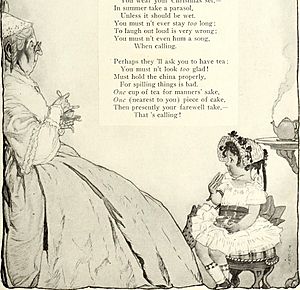Fanny Cory facts for kids
Quick facts for kids Fanny Cory |
|
|---|---|
 |
|
| Born | October 18, 1877 Waukegan, Illinois |
| Died | July 28, 1972 (aged 94) Stanwood, Washington |
| Nationality | American |
| Area(s) | Cartoonist, illustrator |
| Pseudonym(s) | F. Y. Cory, F. Cory Cooney, Fanny Cory Cooney, Fanny Y. Cory, FYC |
|
Notable works
|
Sonnysayings (c. 1920–1956) Little Miss Muffet (1935–1956) |
| Spouse(s) | Fred W. Cooney (m. 1904) |
| Children | Sayre, Robert, Ted |
Fanny Young Cory (born October 17, 1877 – died July 28, 1972) was a talented artist. She drew cartoons and pictures for books. She is most famous for her comic strips called Sonnysayings and Little Miss Muffet. Fanny Cory was one of the very first women in America to have her cartoons published widely in newspapers. She used different names for her work, like F. Y. Cory or Fanny Cory Cooney. But she usually signed her art as Fanny Y. Cory. Sometimes, she just used FYC when she was starting out.
Growing Up and Learning
Fanny Young Cory was born in Waukegan, Illinois, on October 17, 1877. Her parents were Benjamin Sayre Cory and Jessy Salter McDougall. Even as a young child, Fanny loved to draw. She would sketch on anything she could find.
When Fanny was ten, her mother passed away. Two years later, her father moved the family to Helena, Montana. When Fanny was 14, she started learning art from Mary C. Wheeler. Mary was the art supervisor for the Helena schools.
In 1894, Fanny's older brother Jack and his wife invited her to live with them in New York. Two years later, Fanny joined the Metropolitan School of Fine Arts. The next year, she was accepted into the Art Students League. Fanny was a top student there. However, her family did not have much money for her schooling. Fanny also wanted to help care for her sister Agnes, who was ill. So, Fanny decided to leave art school.
Becoming an Illustrator

Fanny wanted to support herself and her sister Agnes. So, she began selling her drawings. Her first drawing was sold in 1898 to The Century Magazine. Her career quickly grew. Fanny drew covers and pictures for many popular magazines. These included Century, Harper's Bazaar, Life, Scribner's, The Saturday Evening Post, and St. Nicholas.
Fanny also illustrated many books. She drew pictures for a 1902 edition of Alice's Adventures in Wonderland. She also illustrated Through the Looking Glass by Lewis Carroll. She drew for L. Frank Baum's books, The Master Key and The Enchanted Island of Yew. She also illustrated The Pettison Twins by Marion Hill in 1906. From 1913 to 1926, Fanny took a break from her career. She wanted to focus on raising her children.
To relax, Fanny started painting beautiful watercolors. She painted fairies, flowers, birds, and small animals. She made one painting for each letter of the alphabet. Each painting also had a poem. She called this collection her "Fairy Alphabet." Fanny thought these paintings were her best work. The Montana Historical Society museum showed these paintings in the 1950s. However, The Fairy Alphabet was not published as a book until the 1980s. The book was released again in 2011.
Creating Comic Strips
Fanny Cory tried drawing cartoons before. Her first attempt was called Ben Bolt, or, The Kid You Were Yourself, but it was not successful. In the 1920s, Fanny needed money to send her children to college. So, she decided to try cartooning again. She started drawing a single-panel cartoon called Other People's Children.
In 1926, Fanny began her favorite comic strip, Sonnysayings. It was sent to newspapers by the Ledger Syndicate. This comic featured a very smart 5-year-old boy and his thoughts about the world. Sonnysayings appeared in many newspapers across the United States, Canada, Australia, and Scotland. It was published under the name Fanny Y. Cory.
By 1935, Sonnysayings moved to King Features. It continued to run there until Fanny retired in 1956. The cartoon was so popular that a book collection was published in 1929.
In 1935, Fanny launched another comic strip called Little Miss Muffet. This strip was also sent out by King Features. It ran until June 30, 1956. Little Miss Muffet was created to compete with another popular comic, Little Orphan Annie. It followed the adventures of an orphan girl named Milly Muffet and her dog. From 1940 to 1946, Tecla Scheuring wrote Little Miss Muffet. A comic book version of Little Miss Muffet was published in 1948 and 1949.
Her Life and Family
Fanny returned to Montana in 1902 after her sister Agnes passed away. Her brothers, Jack and Bob, wanted to try gold mining. They invited Fanny to join them. The siblings built three cabins northeast of Helena, close to the mine. Fanny called her cabin a "studio."
In 1904, Fanny married Fred Cooney. They moved to his ranch on the Missouri River near Canyon Ferry. Fanny loved ranch life. She would draw her illustrations with her drawing board on her lap. She sat by the window in the living room of their ranch house. She also planted large gardens and canned the food she grew. She even decorated her canning labels with her own illustrations!
Fanny and Fred had three children: Sayre, Robert, and Ted. In 1951, Fanny was honored as Montana Mother of the Year. Fanny retired from her work in 1956. She then moved to the Puget Sound area to be closer to her daughter, Sayre. Fanny Cory passed away in 1972 in Stanwood, Washington.
Her brother J. Campbell Cory also became a cartoonist. Fanny Cory was also related to Kate Cory. Kate was famous for her photographs and paintings of the Hopi people.

